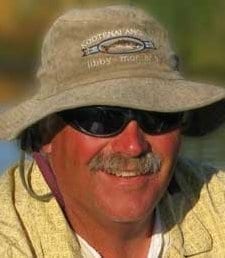CalTrout Interview: Pit River and Fall River Guide Art Teter
After guiding on the Pit River for more than 25 years, Art Teter tells us what he thinks of the Pit River’s new flow regime.

Art Teter
We’re always eager to talk to Art (he sometimes lets fly fishing tips slip, which we immediately steal and claim as our own). This time we wanted his take on a post-relicensing Pit River and the new, higher flows which many have predicted would ruin the river for fly fishermen.
As always, Art offers up his typically candid take on the Pit — how it’s changed, where it’s going, and how fly fishermen should adapt.
/Interview On
Q: How many days would you usually guide on the Pit River?
I usually average 75-80 days per year on the Pit River.
Q: How many did you guide last year?
I think 18.
Q: Wow.
That’s a big difference.
Q: Are you turning more anglers away, or are they staying away?
Because of what they’ve heard about the higher flows on the Pit, they’re mostly staying away. I have had to become more careful about who I take down there, and I work harder at screening people on the phone.
In a way, it’s too bad. People who don’t need to stay away are, and that’s a shame. The fishing has been good.
We’ve had some really, really big number days down there, but you have to want it. The more physical you are, the bigger the reward — both in size and volume of fish.
I had a trip in November with a guy who is a good angler, and he caught around 75 fish by himself.
After only one season, it’s not clear yet how the flows are going to affect the fish, at least not for a couple seasons. But all along those numbers were there.
That said, you have be aware of the current when wading. It’s the volume of the water, not the depth. It’s the pressure on your knees that you need to be aware of.
Q: As a guide, have you found new spots? How have you adapted?
No, I’ve mostly found different ways to fish the same areas.
Really, you’re only looking at a difference in depth of 6″-12″, which doesn’t sound like much, but you need to be three times as careful.
We’re seeing a lot of fish moving out of the middle of the channel to the margins. These days, the fish can be anywhere from one bank to the other. I carry a staff in one hand and a shortline rod in the other and fish the water in the margins.
You’d be amazed when you throw into a spot that looks like it has 6″ of water — boom! Out comes a big fish. Too many people just charge right out to that good-looking seam, missing all the secondary lies.
Also what I’ll do is get down there early and see who is there, who’s parked where. So I’m trying to see where people are wading — often you’ll see them wading where the fish have moved to, and your odds of catching them are pretty low.
Once again, you’re looking at that secondary water.
Basically, it is what is, and we just need to go down there and have fun. Last year we caught a lot of fish and we still caught the bigger fish the Pit is famous for. You just have to approach it with a bit more caution.
It’s a shame that so many people are staying away.
Q: How are you handling potential client inquiries about the Pit?
Before, I had a little fear about some of the different age groups I took down there. The Pit has never been a good river for someone who had trouble walking. Now I have to be a little more careful.
Interestingly, the guys that are getting in trouble aren’t really the first-timers; the people that are having problems with it are the people who have fished it a lot, and rely on those memories to tell us where we can wade or not.
A while back, I went across the river at a spot I’d fished a hundred times; it took me almost 1.5 hours to get back. You can’t make those old assumptions about a new Pit.
Q: I understand that due to the snowpack, 2011 was a bad year for finding out what the new Pit River flows are really like.
It turns out the flows were much higher than they were supposed to be. Pit #3 and Pit #4 were consistently 50 cfs – 100 cfs high, and on Pit #5, flows were consistently 100 cfs – 150 cfs higher than we expected. On Pit #5 the flow issues are partly a function of where the gage is placed, and that needs to be resolved.
This is probably the year we’ll probably see what the new flows are really supposed to look like; I don’t think the fishing is going to change that much. We’ll still see the kind of numbers the Pit is famous for.
Also, all the access issues we suffered last year due to the construction of the campgrounds and access facilities should be finished.
The construction was problematic; truck drivers would yell at you; at times the road down to Pit #3 was completely closed, other times it was difficult. You had to know how and when you could — the signs were misleading and it was a mess.
That’s largely finished, though there will be some gravel work and road work in Pit #4.
Q: How did the individual reaches fare?
The river in Pit #3 was able to spread out — it had room. But Pit #4 became really difficult — all of the biologists hired to do the bug and fish surveys said they couldn’t get to the middle of the river to gather data.
That’s because Pit #4 is more canyon-like — it doesn’t have the room to spread out like Pit #3, so it’s become challenging.
The worst was Pit #5 — there really were no spots I could cross at all.
It’s hard to say how bad it will be when flows are lower like they’re supposed to be.
Q: To your experienced eye, how did pressure on the river decrease?
We’re seeing a dramatic decline in business and angling pressure. Some of the surveys said that a majority of people who fished the Pit this year weren’t interested in coming back.
What’s going to happen is that in a few years, you’re going to see these numbers rebound some, but this year’s survey says almost half the people fishing Pit #4 and Pit #5 wouldn’t return.
Hopefully the flows will settle in and some of them will reconsider.
Speaking as a guide, it’s still a great river for catching a lot of fish.
Q: Give us a couple tips for fly fishing the Pit.
First, the Pit is a window fishery; I don’t get really excited until I start seeing bugs in the air. Stay aware of the temperature. The other day the bite went from 11:30 to 2:30, and then it was largely done [ed: this interview conducted during late winter].
During the summer, the mornings and evenings are generally better, and it’s bet to adapt to that reality.
Second, fishermen often focus on the wrong things. When they’re nymphing, fly fishermen often obsess too much over the fly. I tell my clients that far and way the most important thing is your location. Presentation of the fly is #2, and the fly itself is #3 — last on the list.
Q: What do you want to happen on the Pit?
It’s a really complex issue. We’re not asking anyone to put the flows back to 150 cfs. Somewhere around 220 cfs and 250 cfs would be very fishable on Pit #3. Right now, Pit #3 is the easiest to fish, and at 220 cfs it would be great.
I understand the temperature thing on Pit #4 and Pit #5, but those flows are too high. Getting them down to what they’re supposed to be would be a good start.
I think no matter what you do, the fish are going to adapt and the fishermen are just going to have to adapt to it. Still, fishing accounts for something like 98% of the recreational use of the Pit River, and it needs to be safe for those users.
We’re working with Curtis Knight [ed: CalTrout Conservation Director] and the technical review group to try and make this better. I think we’ve got some good points to make.
Q: What would you say to anglers who are staying away from the Pit?
It’s fishing well and the numbers are there — you just have to be careful. This year’s flows could be a lot better, and the fishing could be excellent. Don’t write the Pit off.
Art Teter has guided Northern California’s rivers, streams and lakes for more than 25 years. He runs the Art Teter Guide Service, and is widely acknowledged as one of the most experienced guides on the Pit River (the Fall River is also a specialty). You can visit his website here.







5 Comments
I’m not a fisheries biologist. I’m a weekend fisherman. I used to be able to go to Pit 5, get in the water and wade upstream, hitting each pocket as I passed by. Sometimes the fishing was absolutely unbelievable with good numbers and sizes of trout. I went one time last year and I could do nothing but work my way out to the edge of the stream, fish one or two pockets, then backtrack up onto the slope and fight the poison oak as I moved upstream. Sure, whenever I got my fly into a nice pocket I got a strike, but I was able to fish no more than about 5% of the water.
I was told that the higher flows would increase the number of trout, especially in the slower sections. Well, the frog water still looks like frog water to me, even in the higher flows. From my perspective there is no advantage in this new regime.
John
Art is right on the money…fishing is still good but wading is difficult, even for the most athletic. After 20 years of fabulous Pit fishing, I’ve downgraded this river’s fishability…fewer access points and significantly greater danger. I will still fish it alone but I no longer recommend the fishery.
That is a really good tip particularly to those new to the
blogosphere. Simple but very precise information? Thanks for sharing
this one. A must read post!